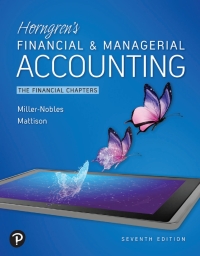Answered step by step
Verified Expert Solution
Question
1 Approved Answer
Hello, Could you help me with the assignment? The King Corporation has ending inventory of $481,060, and cost of goods sold for the year just
Hello,
Could you help me with the assignment?


The King Corporation has ending inventory of $481,060, and cost of goods sold for the year just ended was $4,016,851. a. b. What is the inventory turnover? (Do not round intermediate calculations. Round your answer to 2 decimal places, e.g., 32.16.) What is the days' sales in inventory? (Use 365 days a year. Do not round intermediate calculations. Round your answer to 2 decimal places, e.g., 32.16.) How long on average did a unit of inventory sit on the shelf before it was sold? (Use 365 days a year. Do not round intermediate calculations. Round your answer to 2 decimal places, e.g., 32.16.) c. a. times b. Inventory turnover Days' sales in inventory Days on shelf in inventory days days C. II. Long-term solvency, or financial leverage, ratios Total assets Total equity Total debt ratio = Total assets Debt-equity ratio = Total debt/Total equity TABLE 3.8 Common Financial Ratios 1. Short-term solvency, or liquidity, ratios Current assets Current ratio = Current liabilities Current assets Inventory Quick ratio = Current liabilities Cash Cash ratio Current liabilities Net working capital Net working capital to total assets = Total assets Current assets Interval measure Average daily operating costs Equity multiplier = Total assets/Total equity III. Asset management, or turnover, ratios Cost of goods sold Inventory turnover = Inventory Days' sales in inventory = 365 days Inventory turnover Sales Receivables turnover = Accounts receivable Days' sales in receivables = 365 days Receivables turnover Sales NWC turnover = NWC Fixed asset turnover = Sales Net fixed assets Sales Total asset turnover = Total assets Long-term debt Long-term debt ratio = Long-term debt + Total equity EBIT Times interest earned ratio Interest Cash coverage ratio = EBIT + Depreciation Interest IV. Profitability ratios Net income Profit margin = Sales Net income Return on assets (ROA) = Total assets Net income Return on equity (ROE) = Total equity Sales ROE = Net income Assets Sales Assets Equity V. Market value ratios Price-earnings ratio Price per share Earnings per share PEG ratio Price-earnings ratio Earnings growth rate (%) Price per share Price-sales ratio Sales per share Market-to-book-ratio = Market value per share Book value per share Tobin's Q ratio = Market value of assets Replacement cost of assets Enterprise value-EBITDA ratio = Enterprise value EBITDA
Step by Step Solution
There are 3 Steps involved in it
Step: 1

Get Instant Access to Expert-Tailored Solutions
See step-by-step solutions with expert insights and AI powered tools for academic success
Step: 2

Step: 3

Ace Your Homework with AI
Get the answers you need in no time with our AI-driven, step-by-step assistance
Get Started


